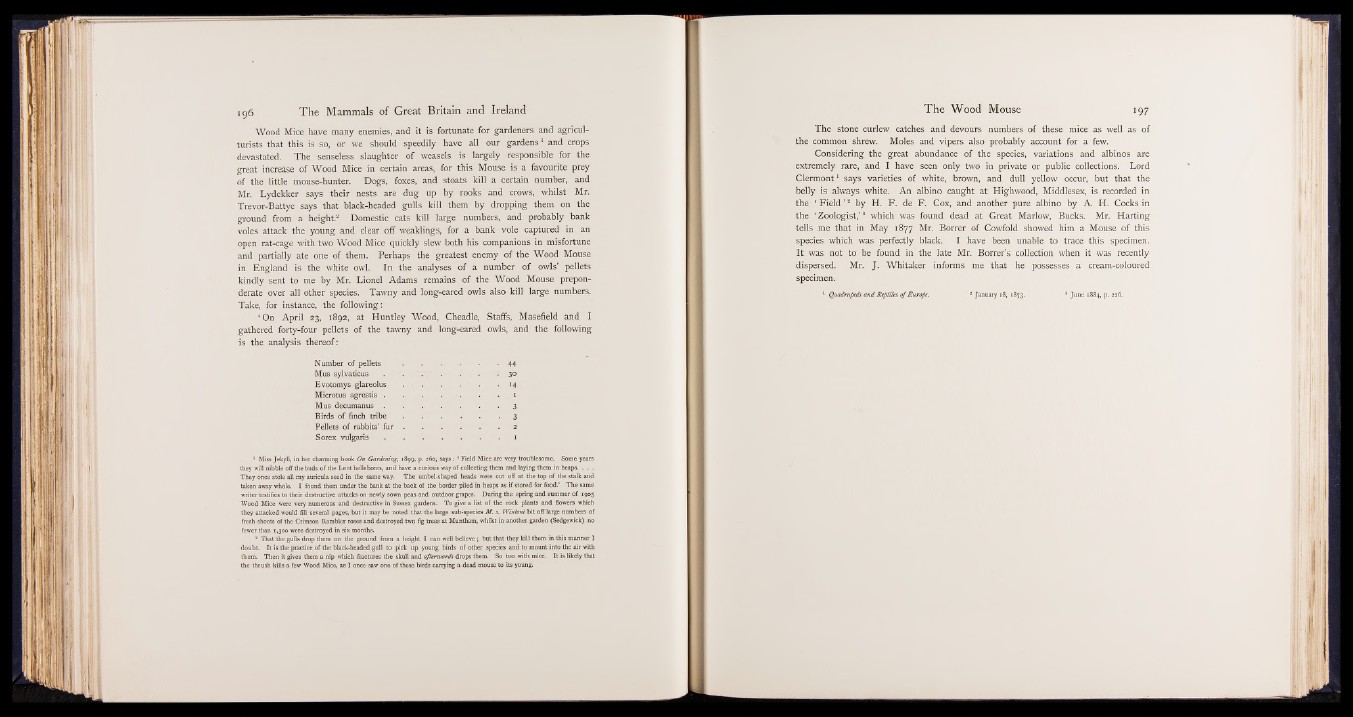
Wood Mice have many enemies, and it is fortunate for gardeners and agriculturists
that this is so, or we should speedily have all our gardens1 and crops
devastated. The senseless slaughter of weasels is largely responsible for the
great increase of Wood Mice in certain areas, for this Mouse is a favourite prey
of the little mouse-hunter. Dogs, foxes, and stoats kill a certain number, and
Mr. Lydekker says their nests are dug up by rooks and crows, whilst Mr.
Trevor-Battye Says that black-headed gulls kill them by dropping them on the
ground from a height.2 Domestic cats kill large numbers, and probably bank
voles attack the young and clear off weaklings, for a bank vole captured in an
open rat-cage with two Wood Mice quickly slew both his companions in misfortune
and partially ate one of them. Perhaps the greatest enemy of the Wood Mouse
in England is the white owl. In the analyses of a number of owls’ pellets
kindly sent to me by Mr. Lionel Adams remains of the Wood Mouse preponderate
over all other species. Tawny and long-eared owls also kill large numbers.
Take, for instance, the following:
‘ On April 23, 1892, at Huntley Wood, Cheadle, Staffs, Masefield and I
gathered forty-four pellets of the tawny and long-eared owls, and the following
is the analysis thereof:
N um b e r o f p ellets ............................................44
M u s sy lv a t icu s . . . • .3 0
E v o tom y s glareo lu s • ~ • - 1 4
M ic rotu s a g re s t is . ............................................i
M u s decumanus .................................3
B ird s o f finch trib e ................................. 3
P e lle ts o f rabbits’ fu r . ................................................2
S o r e x v u lg a ris ............................................I
1 Miss Jekyll, in her charming book On Gardening, 1899, p. 260, says: * Field Mice are very troublesome. Some years
they will nibble off the buds of the Lent hellebores, and have a curious way of collecting them and laying them in heaps. . . .
They once stole all my auricula seed in the same way. The umbel-shaped heads were cut off at the top of the stalk and
taken away whole. I found them under the bank at the back of the border piled in heaps as if stored for food.’ The same
writer testifies to their destructive attacks on newly sown peas and outdoor grapes. During the spring and summer of 1905
Wood Mice were very numerous and destructive in Sussex gardens. To give a list of the rock plants and flowers which
they attacked would fill several pages, but it may be noted that the large sub-species M. s. Winioni bit off large numbers of
fresh shoots of the Crimson Rambler roses and destroyed two fig trees at Muntham, whilst in another garden (Sedgewick) no
fewer than 1,300 were destroyed in six months.
2 That the gulls drop them on the ground from a height I can well believe; but that they kill them in this manner I
doubt. It is the practice of the black-headed gull to pick up young birds of other species and to mount into the air with
them. Then it gives them a nip which fractures the skull and afterwards drops them. So too with mice. It is likely that
the thrush kills a few Wood Mice, as I once saw one of these birds carrying a dead mouse to its young.
The stone curlew catches and devours numbers of these mice as well as of
the common shrew. Moles and vipers also probably account for a few.
Considering the great abundance of the species, variations and albinos are
extremely rare, and I have seen only two in private or public collections. Lord
Clermont1 says varieties of white, brown, and dull yellow occur, but that the
belly is always white. An albino caught at Highwood, Middlesex, is recorded in
the ‘ Field ’ 2 by H. F . de F . Cox, and another pure albino by A. H. Cocks in
the ‘ Zoologist,’ 8 which was found dead at Great Marlow, Bucks. Mr. Harting
tells me that in May 1877 Mr. Borrer of Cowfold showed him a Mouse of this
species which was perfectly black. I have been unable to trace this specimen.
It was not to be found in the late Mr. Borrer’s collection when it was recently
dispersed. Mr. J . Whitaker informs me that he possesses a cream-coloured
specimen.
Quadrupeds and Reptiles o f Europe. 2 January 18, 1873. 3 June 1884, p. 226.